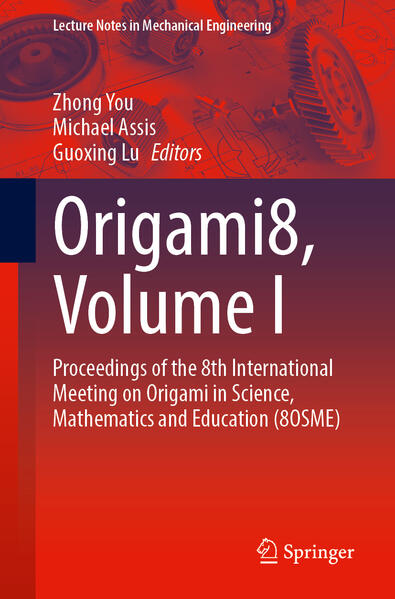
Zustellung: Do, 10.07. - Mi, 16.07.
Versand in 4 Wochen
VersandkostenfreiBestellen & in Filiale abholen:
These four volumes of proceedings contain 126 papers contributed to the 8th International Meeting on Origami Science, Mathematics and Education (8OSME), held on 16-18 July 2024 at Swinburne University of Technology in Melbourne, Australia. The papers represent current work in different disciplines of origami and they are grouped into four subject themes, Volume 1 - Engineering I, Volume 2 - Engineering II, Volume 3 - Mathematics, Computation, History and Mental Health, and Volume 4 - Design and Education.
We witness increasing interests in origami from researchers, practitioners and artists. Of a special note is the rapidly growing research in origami engineering, a distinctive field with fundamental concepts and applications related to space, mechanical, material, medical and structural engineering etc.
Participants of 8OSME should find great passion and opportunity of collaborations across disciplines of origami. We hope these four volumes will inspire not just currently active researchers and artists, but also the next generation of origami scientists, mathematicians, engineers, designers, historians, and teachers.
Chapter 1 is available open access under a Creative Commons Attribution 4. 0 International License via link. springer. com.
Inhaltsverzeichnis
Chapter 1 :Adding more bite to the origami chomper. - Chapter 2:Quaternion-Based Loop Closure Method for Precise Kinematic Simulation of Rigid Origami. -Chapter 3 :Shape Optimization of Rigid Origami for Approximate Self-foldability under Gravity. - Chapter 4 :When will the existence of a non-trivial state guarantee a continuous motion for a quad-mesh rigid origami? . - Chapter 5 :Nonlinear Kinematics of Recursive Origami Inspired by Spidron. - Chapter 6 :Programmable multistability and rigid flattenability in origami cubes by adding a minimal cut. - Chapter 7 :Isometries of trapezoid-based origami. - Chapter 8 :Higher-order infinitesimal mechanism of rigid origami and polynomial approximation of its folding path. -Chapter 9 :Modular Origami Approach for Rigid Foldable Steel Load-Bearing Plate Lattices in Arbitrary Sizes. - Chapter 10 :Woven Rigidly Foldable T-hedral Tubes Along Translational Surfaces. - Chapter 11:Amplifying the kinematics of origami mechanisms with spring joints. - Chapter 12 :Rigid-Foldable Hexagon-Twist Origami Patterns. - Chapter 13 :Framework for the fabrication of flat foldable, thick origami structures via non-rigid origami methods. . - Chapter 14 :Not So Thick Origami. - Chapter 15 :Regular and Semi-Regular Tessellations of Origami Flashers. -Chapter 16 :Constant-Thickness Accommodation by Pattern Modification for Origami Flashers. - Chapter 17 :Cyclic Testing of Membrane Hinges for use in Origami-inspired Engineering Design. - Chapter 18 :A lightweight building construction system using curved-crease origami blocks. - Chapter 19 :Designing Curved Folded Structures through Topology Optimisation. -Chapter 20 :Actuating tubes in multilayer curved folding. - Chapter 21 :Slit folding openings to close along curved foldlines. - Chapter 22 :Rigid-ruling Curved Folding Origami Implemented with Straight Inflated Air Pouches. - Chapter 23 :Kirigami-inspired rectangular iso-area twist tessellations in architecture. - Chapter 24 :Growing kirigami with self-healing and reprogrammable mechanical properties. -Chapter 25:Fabrication of DCRA using Kiri-origami Structure. - Chapter 26:Auxetic Kirigami Pattern inspired by Indusium in a Dictyophora Indusiate. - Chapter 27:A kirigami-inspired folding configuration for Muira thick panel. - Chapter 28:Rotational Erection System (RES) variations: fractals, tessellation, and interlinkage. - Chapter 29 :Folding Condition of Kirigami and Rigid-foldable Kiri-origami Structure with Periodic Incision on Concentric Circles. - Chapter 30 :Design of morphing and multifunctional shape profiles through cutting tessellations.
Produktdetails
Erscheinungsdatum
16. September 2025
Sprache
englisch
Seitenanzahl
1
Reihe
Lecture Notes in Mechanical Engineering
Herausgegeben von
Zhong You, Michael Assis, Guoxing Lu
Verlag/Hersteller
Produktart
kartoniert
Abbildungen
I, 1 p.
ISBN
9789819686636
Entdecken Sie mehr
Bewertungen
0 Bewertungen
Es wurden noch keine Bewertungen abgegeben. Schreiben Sie die erste Bewertung zu "Origami8, Volume I" und helfen Sie damit anderen bei der Kaufentscheidung.









